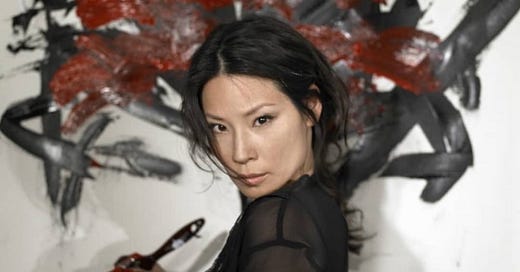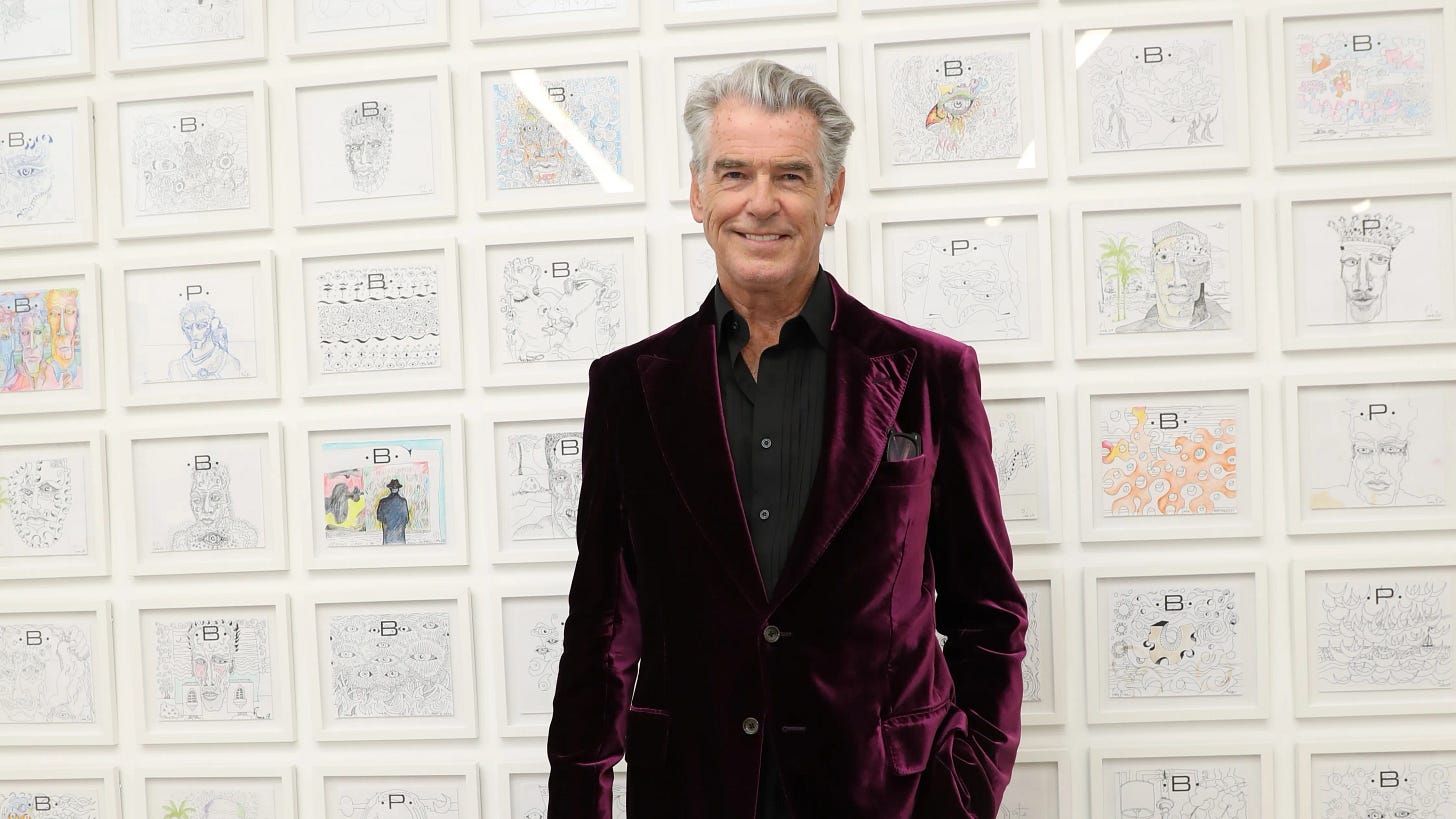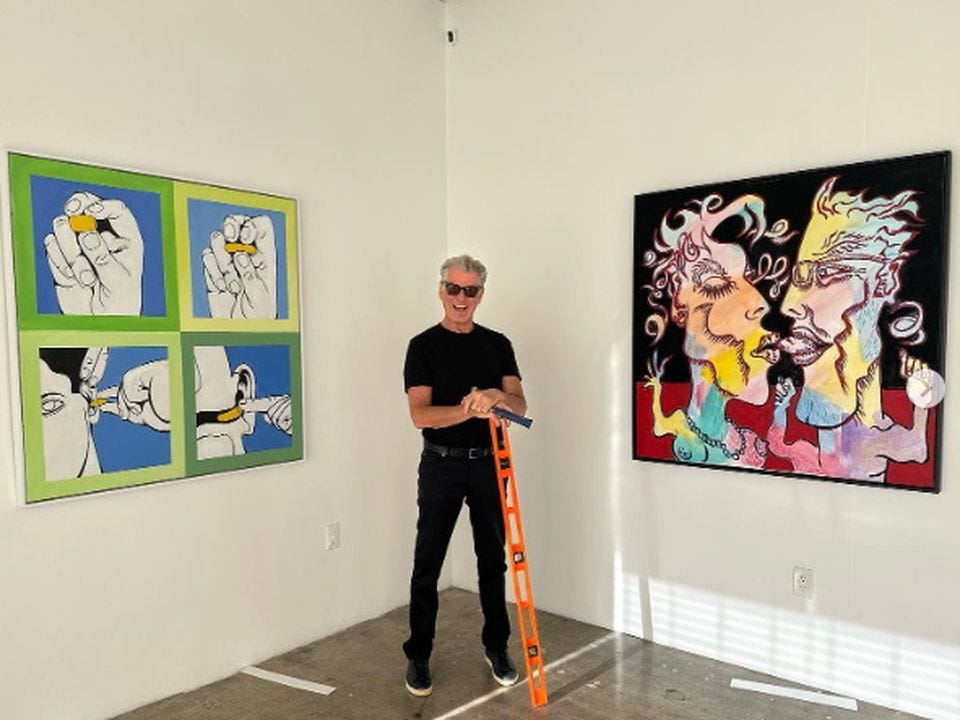From lights to canvas: Unmasking the artistic souls of screen and music icons
They serve as inspirations to all those seeking to break free from the constraints of public perception and embrace the artist within.
Lucy Liu: The multifaceted artistic journey of an Angel
Breaking free from the shackles of preconceived notions can be an arduous task, especially for those who have achieved recognition in the world of film and television. Lucy Liu, the versatile actress celebrated for her captivating performances on both the big and small screens, most especially as Alex Munday in two Charlie’s Angels films, faced this challenge head-on. To be taken seriously as an artist, she embraced her Chinese name, Yu Ling, for her forays into the realm of visual art.
Like many individuals on a creative quest, Liu harbored a deep fascination for visual art from a young age. In the 1980s, during her teenage years in Queens, New York, she delved into photography and ventured into the world of collage. Her talent caught the attention of the art community, and in 1993, an exhibition of her photographs at Cast Iron Gallery in New York granted her a grant, not only to explore her artistic pursuits but also to delve into her cultural heritage at Beijing Normal University.
However, it was not until 2007, after dedicating herself to the study of painting at New York Studio School, that Liu discovered a profound avenue for her artistic expression. The journey of self-discovery unfolded, and the multifaceted artist within her began to emerge fully.

In 2019, a significant milestone awaited Liu as she presented her artworks in “Unhomed Belongings,” a captivating two-person exhibition alongside Singaporean artist Shubigi Rao at the esteemed National Museum of Singapore. Reflecting on this pivotal moment, Liu shared her profound experience with Artsy, stating, “It was probably the most significant moment as an artist that I’ve had. What I really loved was that there was no exchange, it wasn’t about selling; it was about sharing. That felt so good when people showed up and were actually looking at the work, closely and curiously. It made me feel very connected... It was a way of understanding you are not really detached, and you are part of something.”
In that moment, amidst the carefully curated exhibition, Liu experienced the profound power of art to bridge the gaps that often separate individuals. It was a testament to the innate human desire to connect, to be seen, and to share in the experience of artistic expression. Through her artwork, Liu found a profound sense of belonging, transcending the confines of her on-screen persona.
Lucy Liu, or Yu Ling, has seamlessly traversed the boundaries of artistic mediums, captivating audiences with her performances on screen while fearlessly exploring her inner creative realm. Her journey serves as an inspiration to all those seeking to break free from the constraints of public perception and embrace the artist within. With each brushstroke, photograph, or collage, Liu reminds us that art is a vessel of connection, uniting us in a shared human experience.
Pierce Brosnan: From 007 to the canvas
Amidst the myriad of debates that James Bond fans engage in, there exists one undeniable fact they all agree upon — only one 007 harbored a fervent desire to become a painter before donning the iconic agent’s tuxedo.
Pierce Brosnan, the charismatic actor who graced the silver screen as James Bond, embarked on an unexpected artistic path. Leaving school at the tender age of 16, Brosnan found himself hired as a trainee commercial illustration artist in South London, despite lacking any prior experience. Reflecting on that transformative period, Brosnan shared with ARTnews, “I was this young man with aspirations to do album covers. I’d found my passion. For the first time in my life, I was surrounded by artists. They only let me draw the straight lines. I’d make cups of tea and water the spider plants. I was so happy.” Little did he know that the world of acting would soon come knocking on his door.
As fate would have it, Brosnan’s journey led him to Hollywood. Determined to nurture his artistic inclinations, he amassed a studio’s worth of art supplies. However, his brushes rarely graced the canvas until a pivotal moment in his life. In 1986, when his wife was diagnosed with ovarian cancer, Brosnan turned to painting as a cathartic outlet to alleviate the worry and anguish that plagued his heart. Two paintings marked the beginning of a profound artistic journey that has endured to this day.
Just recently, Brosnan proudly showcased his artwork in a hometown solo exhibition at Control Gallery on North La Brea Avenue in Los Angeles. The exhibition boasted an impressive collection of 100 drawings and 50 paintings, including one of the two pieces he created 36 years ago when he rekindled his artistic practice. When asked about the disparities between acting and painting, Brosnan eloquently expressed, “It’s a much more insular feeling, to show your work as an artist, as a painter. There are always moments of doubt when you expose yourself in that way, but as in life, all roads lead to ‘if not now, when?’”
The artistic journey of Pierce Brosnan serves as a testament to the unpredictable twists and turns that life can take. From his humble beginnings as a trainee artist to becoming a global icon as James Bond, Brosnan’s passion for painting remained steadfast. Through his artwork, he found solace, self-expression, and a means to navigate the complexities of his own emotions.
Beyond the silver screen, Brosnan’s creative spirit found refuge on the canvas, allowing him to explore the depths of his artistic soul. As he continues to captivate audiences with his on-screen performances, his parallel artistic identity as a painter offers a more intimate connection to his audience. In the vulnerability of artistic expression, doubts may arise, but Brosnan’s unwavering commitment to sharing his art demonstrates that the time for creative fulfillment is now.
The enigmatic world of James Bond may always evoke spirited debates, but the artistic journey of Pierce Brosnan serves as a reminder that even amidst the glamour and excitement of espionage, one can find solace and self-discovery through the brushstrokes of a painter.
Donna Summer: Beyond the dance floor
In a recent online auction by Christie’s, the renowned auction house cast a dazzling spotlight on the multifaceted talent of disco’s iconic diva, Donna Summer. While her music undeniably ignited dance floors and captured the essence of an era, the sale revealed a lesser-known facet of the beloved singer’s creativity — her visual artistry. From photographs and sequined dresses to ephemera and paintings, this unique event celebrated the Queen of Disco in all her artistic glory.
Unearthing this revelation further, the recently released documentary, “Love to Love You, Donna Summer,” directed by Roger Ross Williams and featuring insights from Brooklyn Sudano, Donna Summer’s daughter, unveils the intriguing tale of her mother’s aspirations. Initially drawn to acting, Summer’s journey as an artist was a dynamic and ever-evolving one. “It’s always strange to me that we put people into these boxes, especially people who become famous,” reflects Sudano in an interview with ARTnews. “But really, they are all artists, they’re storytellers who are able to be extremely creative in all these different mediums. It’s just a matter of whether the audience can accept the fact that an artist can be more than one thing. For my mother, she really was an artist in every sense. Her paintings and sketches were just another manifestation of her artistry.”

Sudano fondly reminisces about her mother’s art studio, nestled within the confines of their Thousand Oaks, California, ranch home. A testament to Summer’s relentless creative spirit, the garage-turned-sanctuary showcased multiple canvases simultaneously. As one painting dried, she would effortlessly transition to the next. Initially, these paintings were an intimate expression of Summer’s inner self, devoid of external expectations. “Music was for other people; the painting was really for her own sense of artistry,” reveals Sudano.
Recently, a curated selection of Summer’s artwork, along with handwritten lyrics, performance outfits, and personal items, became available at Christie’s. Many of these pieces adorned the living room and kitchen of their California home during Sudano’s upbringing. Reflecting on the auction, Sudano confides, “It’s a little bittersweet, selling these paintings my sister and I grew up with. My mother’s fans have been so generous to us over the years; it didn’t feel right to keep these things in storage. They are meant to be shared, to be experienced.”
Beyond the glitz and glamour of disco, Donna Summer’s hidden artistic legacy emerges, shedding light on the depth and breadth of her creative prowess. Just as her music resonated with millions, her paintings offer a unique glimpse into her inner world. From vibrant strokes of color to introspective imagery, these visual creations capture the essence of a woman who defied artistic boundaries. With her legacy showcased and her artistry immortalized, Donna Summer’s multidimensional talents serve as a reminder that true artists transcend labels and mediums.
Sylvester Stallone: From the ring to the easel
Rocky Balboa, the beloved fictional boxer immortalized by Sylvester Stallone in the Academy Award-winning 1977 film “Rocky,” has left an indelible mark on the collective consciousness of moviegoers worldwide. Yet, hidden beneath the layers of Stallone’s cinematic triumph lies a lesser-known artistic facet of the acclaimed actor’s journey. Before penning the career-changing screenplay that propelled him to stardom, Stallone painted a striking self-portrait, immortalizing himself as the iconic character.
In a candid interview with Artnet News in 2021, on the eve of a survey exhibition of his work at the Osthaus Museum in Hagen, Germany, Stallone reminisced about his artistic endeavors. “I made a self-portrait with a more defined ‘pug face’ than I had back then, but to capture his sadness, I switched the brush with a screwdriver and carved the eyes,” Stallone revealed, shedding light on the depth and intensity of his creative process.
In a remarkable parallel to his films, Stallone’s paintings revolve around heroic yet flawed male figures. Exploring the duality of the human condition, his art delves into the complexities of masculinity, presenting characters who embody strength alongside vulnerability. “Both in art and film, I looked at figures like Spartacus or Hercules who radiated hyper-reality through their hyper-masculinity,” Stallone explained, highlighting his fascination with archetypal figures that exude a sense of heightened reality.

Stallone, keenly aware of the ease with which actors who venture into the realm of painting can be dismissed, deliberately kept his artwork out of the public eye, ensuring that his pursuits as a filmmaker and actor would be taken seriously. In fact, he boldly expressed that had he been recognized as an artist earlier in life, his acting career might have taken a backseat, relegated to the realm of an afterthought.
For Stallone, painting transcends the boundaries of public perception, offering an intimate connection to a raw and naked truth. It is in this medium that he finds solace and a profound sense of authenticity. “Painting is where I feel close to a bare-naked truth,” he confided, emphasizing the soul-stirring power of artistic expression.
As Stallone’s creative journey continues to unfold, he unveils the layers of his multifaceted identity. From the roar of the crowd in the boxing ring to the delicate strokes of the brush on the canvas, his artistic legacy resonates with an unyielding determination to explore the depths of human emotion and vulnerability.
Beyond the realm of the silver screen, Sylvester Stallone emerges as an artist unafraid to expose his innermost thoughts and struggles. His paintings serve as a poignant testament to the universal quest for self-discovery and the unwavering pursuit of truth. In this revelation, we find inspiration to embrace our artistic inclinations, regardless of the confines of societal expectations, and to discover the raw essence of our own creative journeys.








